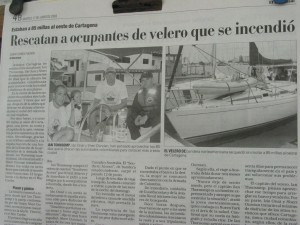 Welcome to our blog for the Plastic in the Pacific Crusade. If you missed the earlier editions please use the category search in the footer to go back and read them. They are listed under Plastic in the Pacific. Over the coming year we will be writing regularly of our adventures and what we are seeing. In this article we write about our trip to Panama and our transit through the Canal.
Welcome to our blog for the Plastic in the Pacific Crusade. If you missed the earlier editions please use the category search in the footer to go back and read them. They are listed under Plastic in the Pacific. Over the coming year we will be writing regularly of our adventures and what we are seeing. In this article we write about our trip to Panama and our transit through the Canal.
The last time I tried to sail from Grenada to Panama, I didn’t make it. O.K we stopped in Aruba as planned but from Aruba to Panama we ended up having a fire in the battery bank courtesy of some electrical work carried out in Aruba. We ended up in Cartegena Columbia and the boat got sold there, so 13 years on and the dream to transit the Panama Canal was still on the bucket list.
Due to piracy issues off the coast of Venezuela we had planned to sail a fair way off the coast the entire way. We didn’t want to risk Columbia as the reason I had been rescued free of charge 13 years ago by the Columbian Coast Guard was due to a piracy attack 40 days earlier off the coast and them wanting some good publicity. So Annika knowing this was worried that we would be attacked so to keep a happy wife, and hence a happy life, we would sail at least 50nm off the coast the whole way, but Annika would prefer it closer to 100nm. It was an argument we had several times. My argument was that in big seas that 50nm was a long way. She just wanted more distance for safety.
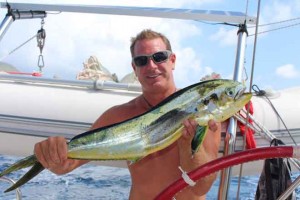 Running the routing through Maxsea and that was our route anyway, to sail slightly north of West for the first 600nm and then gybe and head south. We had excellent winds the whole way and we even caught a good sized dolphin fish that would feed us for 4 meals. So we did little fishing after the 2nd day. It wasn’t till the last day that we launched the rod again, only to catch a small shark, which we put back of course, and then not long after a huge dolphin fish decided to take the lure. I saw him jump out of the water and he was huge. The drag on my rod wouldn’t hold him and I’m glad he broke the line as otherwise the reel was going to run out.
Running the routing through Maxsea and that was our route anyway, to sail slightly north of West for the first 600nm and then gybe and head south. We had excellent winds the whole way and we even caught a good sized dolphin fish that would feed us for 4 meals. So we did little fishing after the 2nd day. It wasn’t till the last day that we launched the rod again, only to catch a small shark, which we put back of course, and then not long after a huge dolphin fish decided to take the lure. I saw him jump out of the water and he was huge. The drag on my rod wouldn’t hold him and I’m glad he broke the line as otherwise the reel was going to run out.
The last few days into Panama were really rough and rolly. The swells were all mixed up and the currents were pushing us all over the place, however they were always against us. We couldn’t run the spinnaker as it was too rolly and light for it meaning it would just thrash around all over the place and with the entire pacific to go we just weren’t going to risk it. One thing we did notice as we got closer to the corner was that the amount of debris was increasing. I guess it all collects down in the corner of the Caribbean. It was the usual plastic bottles and Styrofoam cups and containers. These are the macro plastics, imagine the micro-plastics in the region once these products photo degrade. We really do need to take better care of our oceans.
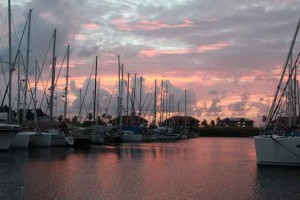 Approaching Panama and we were both getting excited. As per usual, our eta was going to be the middle of the night once again. It really is a bad habit of mine. The first thing you see at night as you approach Colon is the lights. You think it is a large town until you realise it’s actually the ships anchored off. Thankfully I have an AIS receiver linked through my Maxsea and hence we knew which ships were moving and the names. Approaching the walls of Colon and we had two ships inbound and two ships outbound. We slid between them and as soon as you reach the wall, you hook hard to starboard and follow the wall in to Shelter Bay Marina. We entered the marina and all of a sudden for the first time since the Canaries we felt dead flat water. We were allocated berth E12 and as we entered we both looked at the numbering and saw that a boat was in it so we just took E16 as it was empty. We put first line on shore at 0245, same time we arrived in Barbados. In the morning we actually realized E12 was empty. We were just too tired and both got it wrong. Once again sleep deprivation is a crazy thing.
Approaching Panama and we were both getting excited. As per usual, our eta was going to be the middle of the night once again. It really is a bad habit of mine. The first thing you see at night as you approach Colon is the lights. You think it is a large town until you realise it’s actually the ships anchored off. Thankfully I have an AIS receiver linked through my Maxsea and hence we knew which ships were moving and the names. Approaching the walls of Colon and we had two ships inbound and two ships outbound. We slid between them and as soon as you reach the wall, you hook hard to starboard and follow the wall in to Shelter Bay Marina. We entered the marina and all of a sudden for the first time since the Canaries we felt dead flat water. We were allocated berth E12 and as we entered we both looked at the numbering and saw that a boat was in it so we just took E16 as it was empty. We put first line on shore at 0245, same time we arrived in Barbados. In the morning we actually realized E12 was empty. We were just too tired and both got it wrong. Once again sleep deprivation is a crazy thing.
We had organized an agent for our transit as being previously in the industry, we felt it the right thing to do. O.K it was going to cost us some money but we wanted a quick transit with no hassles and felt an agent would be the best. We had an email from him saying our ‘Admeasurer’ would be on the boat in the morning. This is the person from the canal system who measures your boat and ensures it is ready for the transit. We had no idea what time he would come so even though we had arrived at ‘stupid o’clock’ we were up at 0700. By 0830 I had a message apologizing that he wouldn’t make it that day as he had been called to a commercial ship, which takes precedence over recreational vessels. However our agent would be onboard by 12 noon. So we checked in at the office and started cleaning up the yacht.
During our stay on the hard in Grenada, we had greased up the stern bearing and put the boot back on to make it waterproof. For some reason the whole way to Panama it would leak when steaming so we ended up with a lot of salt water in the bilge which sloshed around in the rolly seaway, so we ended up pulling all the floor boards out of the boat to clean and dry them. We also had all the mattresses out to air them and of course we had washing as well. The boat looked like a bomb had hit it. To add to the day I decided that due to being on a marina, I would polish the hull to get the salt burn off which had formed across the Atlantic. This is when salt gets on the hull and the sun cooks it on. It is really hard to get off however with a good polish she was coming up nice once again.
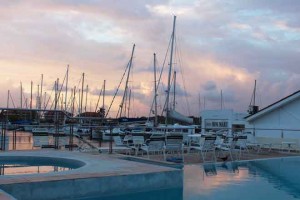 Our agent arrived as planned and even though he advertises his fees at US$350, he will reduce this to $300 if you have been recommended by someone. We managed to get the $300 fee as he had heard about us from someone else. Then he saved us more than this by putting us down as ‘in transit’ rather than checking into the country and having to get cruising permits and visa’s etc. So even though we had paid him $300, we saved about $550 so we were much better off. Better still, he was doing all the hard work for us. He even arranged for the admeasurer to come on a Saturday which usually costs more, and we didn’t pay anything extra. Our agents name was Erick Galvez from Centenario Consulting and he really was easy to deal with. We highly recommend him to anyone and tell him Ocean Crusaders sent you.
Our agent arrived as planned and even though he advertises his fees at US$350, he will reduce this to $300 if you have been recommended by someone. We managed to get the $300 fee as he had heard about us from someone else. Then he saved us more than this by putting us down as ‘in transit’ rather than checking into the country and having to get cruising permits and visa’s etc. So even though we had paid him $300, we saved about $550 so we were much better off. Better still, he was doing all the hard work for us. He even arranged for the admeasurer to come on a Saturday which usually costs more, and we didn’t pay anything extra. Our agents name was Erick Galvez from Centenario Consulting and he really was easy to deal with. We highly recommend him to anyone and tell him Ocean Crusaders sent you.
After a heavy day of work, we headed to the pool to cool off and found out that this was the place for the unofficial ‘sundowners’ for the marina, so all the yachties had met there to ‘talk story’. We caught up with some really nice people who had some great stories about the Pacific. Mike and Robin off S/Y Mermaid had sailed through several years previously and told us about some great diving spots. It was really good to catch up with some yachties and just relax. It was so much better than the Caribbean had been. The marina facilities were excellent and after the swim I had one of the best showers I’ve had in my life. Hot water and space after so many days on the boat made it just perfect for someone as tall as me. Sometimes it’s the simple things in life you miss!!!
 The next day we turned the boat around so I could polish the other side and had our admeasurer come. They measure the overall length of the boat including overhanging davits/tenders and anchors etc. If you go over 50ft you pay an additional $400 odd to get through the canal so when he measured the beam of our tender and from the forestay to the bow and added it to the 43ft we had given him, it came to 48’9”. Didn’t realise we had a 49ft yacht!!!! We are nowhere near that long but I didn’t care as long as it was under 50ft. He then went off to log us in the system and we would find out that night when we would get our transit. We presumed it would be Monday at best and Tuesday at worst, that was what we had been told by Erick. So when we get the message at 1900 that we were going through the next day, all hell broke loose. We had to organize our line handlers to see if they were available at such late and had lots of jobs to do which we had left for the Sunday and the Monday morning.
The next day we turned the boat around so I could polish the other side and had our admeasurer come. They measure the overall length of the boat including overhanging davits/tenders and anchors etc. If you go over 50ft you pay an additional $400 odd to get through the canal so when he measured the beam of our tender and from the forestay to the bow and added it to the 43ft we had given him, it came to 48’9”. Didn’t realise we had a 49ft yacht!!!! We are nowhere near that long but I didn’t care as long as it was under 50ft. He then went off to log us in the system and we would find out that night when we would get our transit. We presumed it would be Monday at best and Tuesday at worst, that was what we had been told by Erick. So when we get the message at 1900 that we were going through the next day, all hell broke loose. We had to organize our line handlers to see if they were available at such late and had lots of jobs to do which we had left for the Sunday and the Monday morning.
Luckily Alexis, a Canadian backpacker, and Thorsten, a German off another yacht near ours, were both available but we couldn’t find a third so we had to ask Erick to organize 1 person. To transit the canal you need 4 line handlers and the skipper. You have to have huge fenders and 7/8” thick mooring lines that are 125ft each. Not having these you rent them for US$60 from your agent. We had these delivered in the morning ready for our transit and Mauricio would be our hired hand. The line handlers you hire are US$100 each.
The morning of the transit we would get up early to do a heap of chores. We had to be off the dock at 1300 to be at the ‘Flats Anchorage’ at 1530 to meet our adviser. It only takes an hour to get there but they recommend you get there early to ensure that if there is an early slot you can go early. You cannot afford to be late as they will charge you even if you don’t go through. We managed to get everything done. Mauricio our hired line handler was awesome. He came onboard early, set up the fenders, laid out the lines and then ate lunch. We were really frustrated with ourselves for not knowing Spanish as it meant conversing with him was very hard but Alexis and Thorsten knew a little so that helped. At 1300 all were on board, we cast off and headed for ‘The Flats’. We arrived at the flats just before 1400 and dropped anchor and sat around and waited.
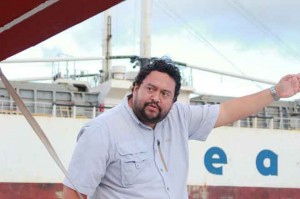 Our adviser Riccardo boarded us at 1445 and was absolutely awesome in explaining everything to us. We lucked out as he was a supervisor and did the training for other advisors. He was first class and a really nice person. One thing that had annoyed us was that Erick told us we had to have bottled water for the advisor. This is because so many of the yachts that go through don’t have good water. Panama has excellent drinking water and they don’t like the taste of desalinated water. Our water is desalinated and then filtered so pretty good quality. We gave Erick a taste and he said it would be OK. But if we hadn’t have pushed then we would have had to provide bottled water which we are totally against, especially if it is in plastic.
Our adviser Riccardo boarded us at 1445 and was absolutely awesome in explaining everything to us. We lucked out as he was a supervisor and did the training for other advisors. He was first class and a really nice person. One thing that had annoyed us was that Erick told us we had to have bottled water for the advisor. This is because so many of the yachts that go through don’t have good water. Panama has excellent drinking water and they don’t like the taste of desalinated water. Our water is desalinated and then filtered so pretty good quality. We gave Erick a taste and he said it would be OK. But if we hadn’t have pushed then we would have had to provide bottled water which we are totally against, especially if it is in plastic.
We were waiting for a certain ship to transit with. We were told that as soon as it entered between the walls of Colon we would heave our anchor and head to the locks. The plan was to transit the first three locks into the lake and then moor up overnight. We would transit the canal and the Pacific side locks the next day. Heading to the locks we were all pretty excited. I was a little nervous as I had heard stories of boats getting damaged due to the turbulence of the water as it rises. We were lucky though, we were transiting with no other boats, just the ship in front of us. Usually they raft up several smaller boats, they call us ‘line handling boats’, together and that is when you can have issues.
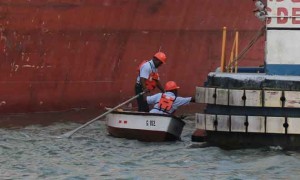 On the Caribbean side, the ships go in front of you. So this big ship comes past us and heads into the lock. They don’t have line handlers for obvious reasons. They use cables that are pulled up onboard by winches. These cables are attached to little train locomotives on the shore that feed the line in and out as necessary and hold the ship off the walls. It is incredible to watch. The funny part is that to get the cables over to the ships, they use a row boat to collect the monkey fist. It is hilarious watching these two guys in a small row boat trying to row in the turbulence of the ship trying to get a line to shore. You’d think there has to be a better way to do it. Once the ship was secure in its position, we moved in. As we entered we moved over to the port side of the lock to have the monkey fists (solid ball attached to a small line) launched from shore over our boom. The line handlers on our port side attached these to our port lines. Then we moved over to starboard and repeated the process. We then motored forward slowly to allow the guys on shore to walk with the lines into the lock. Once in position, they pulled our 4 large lines out and we made fast in the center of the lock. The walls are over 10m tall around you, these two massive doors shut behind you and it is all a bit surreal. The next thing you know the water is turbulent as it rushes in. As you rise up the line handlers have to keep heaving the lines to make sure you stay in the middle. We were told it takes 30 minutes per lock but I reckon the first one went in the space of about 5 minutes, it felt that fast. As you rise quickly with the incoming waters, you start to be able to see over the back door and once full you can look down on the Caribbean. This is something to behold. Wow, what a view. What a feat of engineering this is.
On the Caribbean side, the ships go in front of you. So this big ship comes past us and heads into the lock. They don’t have line handlers for obvious reasons. They use cables that are pulled up onboard by winches. These cables are attached to little train locomotives on the shore that feed the line in and out as necessary and hold the ship off the walls. It is incredible to watch. The funny part is that to get the cables over to the ships, they use a row boat to collect the monkey fist. It is hilarious watching these two guys in a small row boat trying to row in the turbulence of the ship trying to get a line to shore. You’d think there has to be a better way to do it. Once the ship was secure in its position, we moved in. As we entered we moved over to the port side of the lock to have the monkey fists (solid ball attached to a small line) launched from shore over our boom. The line handlers on our port side attached these to our port lines. Then we moved over to starboard and repeated the process. We then motored forward slowly to allow the guys on shore to walk with the lines into the lock. Once in position, they pulled our 4 large lines out and we made fast in the center of the lock. The walls are over 10m tall around you, these two massive doors shut behind you and it is all a bit surreal. The next thing you know the water is turbulent as it rushes in. As you rise up the line handlers have to keep heaving the lines to make sure you stay in the middle. We were told it takes 30 minutes per lock but I reckon the first one went in the space of about 5 minutes, it felt that fast. As you rise quickly with the incoming waters, you start to be able to see over the back door and once full you can look down on the Caribbean. This is something to behold. Wow, what a view. What a feat of engineering this is.
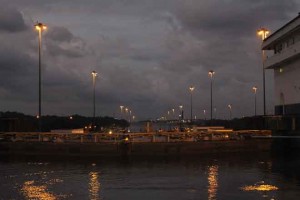 Once the lock is full, the front doors open up and the ship went to the next lock with the locomotives. They use their engine to slowly move forward and to stop. Once in position we release our lines off the shore and pull them back on the boat with the monkey fist and the smaller line still attached. We then motor into the 2nd lock at walking pace so the guys ashore can keep up. All the time our advisor was explaining everything so clearly it made it easy. He even helped Alexis when she needed it and I was assisting Annika when she needed it. Seemed the guys up the front were all good as Mauricio had Thorsten under control. The process is repeated in the second lock, the lines go up, we tie off, the doors close, we get floated another 9m and then move to the next lock. By the time we got to the final lock it was starting to get dark but that made it even better. Transiting locks by dusk, it was unreal. It was a dream coming true. Another tick on the bucket list.
Once the lock is full, the front doors open up and the ship went to the next lock with the locomotives. They use their engine to slowly move forward and to stop. Once in position we release our lines off the shore and pull them back on the boat with the monkey fist and the smaller line still attached. We then motor into the 2nd lock at walking pace so the guys ashore can keep up. All the time our advisor was explaining everything so clearly it made it easy. He even helped Alexis when she needed it and I was assisting Annika when she needed it. Seemed the guys up the front were all good as Mauricio had Thorsten under control. The process is repeated in the second lock, the lines go up, we tie off, the doors close, we get floated another 9m and then move to the next lock. By the time we got to the final lock it was starting to get dark but that made it even better. Transiting locks by dusk, it was unreal. It was a dream coming true. Another tick on the bucket list.
After our final lock, we motored around to a mooring a couple of miles away and tied up side on to the mooring. The moorings are huge so hanging off the bow wasn’t an option as you could bump them all night. Best to be tied up to them so no bumping. Riccardo got picked up by the pilot boat not long after. The lakes are fresh water and have fresh water crocodiles in them. After dinner, it didn’t stop us all from going for a swim. It was awesome to swim in fresh water again. Kind of unique too to dive off your yacht into fresh water. It was like swimming in the pools at the bottom of the waterfalls in Litchfield national park in the Northern Territory. It was beautiful. Susky was floating in fresh water. WOW.
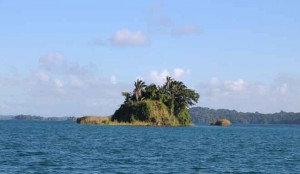 In the morning we had been told our next advisor would join us at 0630 so we were up early and had breakfast. Our advisor would arrive at closer to 0730 and as soon as he stepped aboard we cast off and headed south. He too was called Riccardo. We started to think they might all be called Riccardo! It is 28nm to transit from one end to the other. He told us there was a lock available at 1130. Probably not in our capability but we would try and hopefully they would be a little late. The eastern side of the lakes has many islands and would be the ideal water skiing lake if you were allowed to use it for recreation. We were chasing an American Passport 545 cruising yacht and they literally steamed away from us averaging 8.2 knots whilst we were doing 6.5. We tried to cut corners and keep up but they disappeared pretty quickly. They’d make 1130 no worries. The islands kind of reminded me of the islands of Thailand where they just stuck up out of the water and were covered in lush green vegetation.
In the morning we had been told our next advisor would join us at 0630 so we were up early and had breakfast. Our advisor would arrive at closer to 0730 and as soon as he stepped aboard we cast off and headed south. He too was called Riccardo. We started to think they might all be called Riccardo! It is 28nm to transit from one end to the other. He told us there was a lock available at 1130. Probably not in our capability but we would try and hopefully they would be a little late. The eastern side of the lakes has many islands and would be the ideal water skiing lake if you were allowed to use it for recreation. We were chasing an American Passport 545 cruising yacht and they literally steamed away from us averaging 8.2 knots whilst we were doing 6.5. We tried to cut corners and keep up but they disappeared pretty quickly. They’d make 1130 no worries. The islands kind of reminded me of the islands of Thailand where they just stuck up out of the water and were covered in lush green vegetation.
Half way through the islands it becomes a channel and narrows up substantially. Seeing these big ships carve through the channel was awesome. At the half way point the advisor was told that our lock would be at 1300 so we had plenty of time. So we backed off the revs a little to be cruising at 6 knots. We passed where they were dredging and widening the channel as they are building new locks to take bigger ships. Currently they can take 1000ft ships and they are increasing this up to 1250ft with a new set of locks. Eventually they plan to make the whole channel two way but currently the southern end is still single file so all the ships were coming at us. Our ship that we would transit the locks with was holding back until the last northbound ship had passed the dredging area. Then they would make their way to the southern locks. We passed under the Centennial Bridge with a cruise ship coming the other way. We then slowed ourselves even more as we were waiting for our ship and we knew they were a long way behind. We eventually made the first lock but held back and just drifted around killing time.
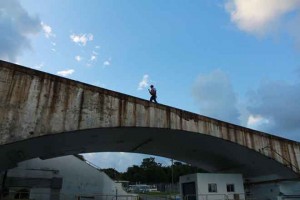 This time we would transit with the Passport 545 and a passenger ferry. Whilst in the Gatum locks on the Pacific side we had to handle all four lines, this time the ferry would tie up to the wall, the passport to it and then we would tie up to the passport so we only had to handle the lines to tie up and then sit and wait. On the Pacific side, the ships go behind you and there is less turbulence going down than up, however we were advised that there is a current heading with us in the locks that gets stronger and stronger with each lock. We had to tie up starboard side to which meant our stern would kick away from the boat we were tying up to as we stopped. Not ideal but on the first attempt with very little wind and current, I got it perfect and ‘kissed’ the other boat. The ship came in behind us and down we went. There is 0.9nm between the 1st and 2nd lock on the Pacific side so we pulled away first and pulled to one side to allow the Passport and the cruise boat to go ahead. We repeated the process of tying up one at a time but this time the current was much stronger. The water still leaks through the gates so it is always trying to pull you towards the door. We got the ropes across but as I stopped the boat the stern kicked to port and the water was rushing between the two boats trying to pull them apart. Lucky I am big and used brute force to pull the boats together. We then went down another 9m.
This time we would transit with the Passport 545 and a passenger ferry. Whilst in the Gatum locks on the Pacific side we had to handle all four lines, this time the ferry would tie up to the wall, the passport to it and then we would tie up to the passport so we only had to handle the lines to tie up and then sit and wait. On the Pacific side, the ships go behind you and there is less turbulence going down than up, however we were advised that there is a current heading with us in the locks that gets stronger and stronger with each lock. We had to tie up starboard side to which meant our stern would kick away from the boat we were tying up to as we stopped. Not ideal but on the first attempt with very little wind and current, I got it perfect and ‘kissed’ the other boat. The ship came in behind us and down we went. There is 0.9nm between the 1st and 2nd lock on the Pacific side so we pulled away first and pulled to one side to allow the Passport and the cruise boat to go ahead. We repeated the process of tying up one at a time but this time the current was much stronger. The water still leaks through the gates so it is always trying to pull you towards the door. We got the ropes across but as I stopped the boat the stern kicked to port and the water was rushing between the two boats trying to pull them apart. Lucky I am big and used brute force to pull the boats together. We then went down another 9m.
The trip from the 2nd to 3rd lock is interesting. Because the locks are joined together, it doesn’t give a lot of time to disconnect from the raft up, let the other two boats pass and tie up, and then for you to go back in. The current was rushing at 3 knots which made it even harder and as I tried to slow the boat, it kept trying to go sideways. The passport did it easy with his bow thruster!!!! All the time this huge ship is moving forward towards you and almost pushing you to get tied up quickly. The pressure was on. We managed to get it all sorted and tied up for the final time in the lock. The next time the doors opened we would be out in the Pacific, in our own pond once again, just the wrong side of it. Off to the left of the final lock is a huge high rise with hundreds of people looking on. Seeing the locks is one thing, experiencing it is another. To do it on your own boat is the ultimate. Annika and I had ticked that life box and it felt amazing as those doors opened.
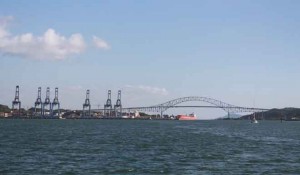 Leaving the lock and the current was rushing behind us. We took off towards Balboa Yacht Club where we would stay a few nights whilst we provisioned and got ready to depart to the Galapagos Islands, an 880nm journey through the doldrums. We were in the Pacific. It was awesome just to know that on the other side of this ‘pond’ was home. But more importantly for us, now we could start the real ‘Plastic in the PACIFIC Crusade’
Leaving the lock and the current was rushing behind us. We took off towards Balboa Yacht Club where we would stay a few nights whilst we provisioned and got ready to depart to the Galapagos Islands, an 880nm journey through the doldrums. We were in the Pacific. It was awesome just to know that on the other side of this ‘pond’ was home. But more importantly for us, now we could start the real ‘Plastic in the PACIFIC Crusade’
In our next edition we provision up the yacht for the Pacific and head across to the Galapagos via the Perlas Islands.
Ocean Crusaders are out to change the way people treat our oceans. Our online education program is free to download at www.OceanCrusaders.org/education where children can learn of the issues our oceans are facing and how they can make a difference. The Plastic in the Pacific Crusade is about educating the South Pacific Islands, finding out what is happening in these islands and updating our programs. You can join us in the Pacific and see for yourself what we do.
Ocean Crusaders Plastic in the Pacific Crusade is proudly supported by: Cressi Dive Gear, Gill Marine, Keen Footwear Australia, Barz Optics Sunglasses, Maxsea Navigation Software, Digital Diver Cairns, LED Dive Lights Australia, Boat Names Australia, Predictwind Weather & Sail-world.com
[cincopa AkAALItEMOR5]